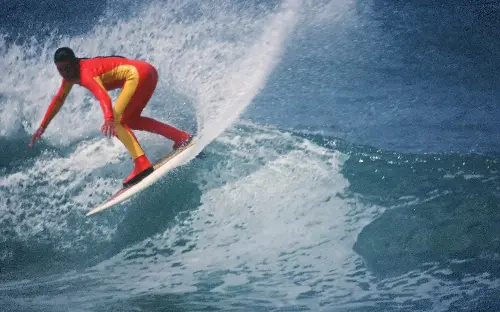
There’s a Cornish word, mordros, for the relentless sound of the sea. You barely hear it in Falmouth harbour, outside the National Maritime Museum Cornwall; but inside their new exhibition, Surf!, it’s inescapable. The very first video, on a passage wall, gives you both that roar and a surfer’s-eye view of a perfect tube. You glide across water like blue-green glass. The wave curls and breaks above you, foam at its leading edge. This, to any surfer, is bliss.
Surf! is a whirl of 350 objects, ranging from surfboards and vintage magazines to a VW campervan in ’60s trim. You survey the century-old history of Cornish surfing, which amounts – since Cornwall was where Britons got on their boards – to discovering what this old Polynesian hobby, or sport, or lifestyle, has done for our culture generally. Curator Sam Bleakley, a man with salt sea in his veins, has spent over a year sourcing these objects, then laying them out among briskly informative labels and videos in which surfers ride and fall.
The heroes are the boards, 103 of them, elegant monoliths arranged around the hall. As their shapes and sizes change, so does social history. The first one, from the 1920s, resembles a coffin lid, and was carved by the local undertaker in nearby Perranporth. Back then, “prone” riding was the way: surfers lay flat, as bodyboarders do. The assimilation, as you learn, was at this point going well. A 1930 Southern Railway poster offers “Bude, for Sunshine and Surfing”. Woollen swimsuits abound. On the cover of a 1945 issue of Illustrated magazine, a smiling young woman stands in the shallows, toting a wooden board: “a war worker on holiday”.
Over the next few decades, the boards got longer and the riders leapt to their feet. Some beaches, in the late 1960s, banned surfers from doing this, notionally for reasons of safety but with an understreak of disdain. The police would descend on beaches to keep the middle-class picture of peace. Surfing acquired, or was given, an edge – hippies, Californians, “alternative” types, allergic to mainstream society – a profile that endures.
But society owes them thanks. In “Activism”, a section that might have been larger, you see how the collective Surfers Against Sewage, formed in 1990, fired an early salvo in what’s now a war, waged from across the political spectrum, against the poisoning of our waterways.
This exhibition means something to me: I grew up surfing in south Wales, which in climate, atmosphere and (whisper it) quality of surf, could be Cornwall’s Celtic twin. I was inclined to be impressed, then, and I feel churlish in suggesting flaws – that the show’s a little overstuffed for the modest space; that some corners seem accordingly cramped; that the small skateboarding display wasn’t, to my mind, justified. In every other respect, Surf! is relentlessly fascinating, and shows how an apparently marginal activity captured Britain’s changing face. At the same time, it conveys something more elemental: what it is to paddle out, turn back to the shore, and feel momentarily free.
Until Jan 2027; nmmc.co.uk